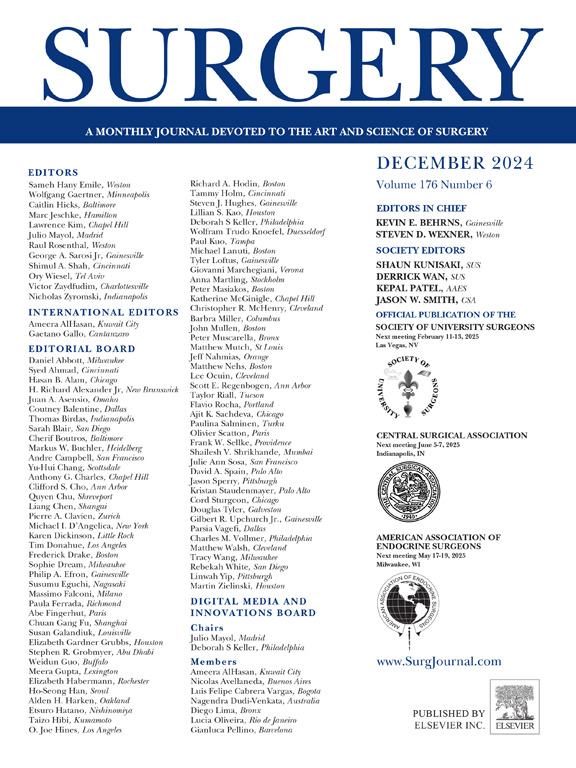日本机器人辅助超低前切除术和机器人辅助直肠切除术经肛门吻合术治疗直肠癌的短期疗效:一项多中心回顾性队列研究(ROSEMARY研究)
IF 2.7
2区 医学
Q1 SURGERY
引用次数: 0
摘要
背景:复杂的超低前切除术和括约肌间切除术需要在骨盆最深处进行精确的操作,尽管此类手术的报道有限,但机器人手术的优势尤其可以被利用。我们的目的是评估日本31家机构中机器人辅助的超低前切除术和机器人辅助的括约肌间切除术的短期效果。方法本多中心回顾性研究以日本内镜外科学会的调查为基础,选取机器人辅助直肠癌手术数量最多的31家机构进行。我们回顾性分析了一组在2020年1月至2021年12月期间接受机器人辅助的直肠癌超低前切除术或机器人辅助的括约肌间切除术的患者。结果本研究共纳入1250例患者,排除40例,最终纳入1210例患者(其中机器人辅助超低前切除术886例,机器人辅助括约肌间切除术324例)。中位手术时间为364分钟(四分位数范围277-479分钟),出血量为17 mL(四分位数范围0-50 mL),在机器人辅助的超低前切除术中,只有1例患者转为开腹手术。术后30天内出现Clavien-Dindo III级及以上并发症109例(9.0%),其中吻合口漏最常见(3.4%),肠梗阻次之(1.3%),术后30天内死亡罕见,仅有1例死亡。结论ROSEMARY的研究证实了机器人辅助下的低位直肠癌超低前切除和括约肌间切除的可行性和安全性。本文章由计算机程序翻译,如有差异,请以英文原文为准。

Short-term outcomes of robot-assisted ultralow anterior resection and robot-assisted rectectomy with transanal anastomosis for rectal cancer in Japan: A multicenter retrospective cohort study (ROSEMARY study)
Background
The complex procedures of ultralow anterior resection and intersphincteric resection require precise manipulation at the deepest pelvis, where the advantages of robotic surgery in particular could be leveraged, despite limited reports of such procedures. We aimed to evaluate the short-term outcomes of robot-assisted ultralow anterior resection and robot-assisted intersphincteric resection at 31 institutions in Japan.
Methods
This multicenter retrospective study was performed by a total of 31 institutions with the largest number of robot-assisted rectal cancer surgeries based on the survey conducted by the Japan Society for Endoscopic Surgery. We retrospectively analyzed a cohort of patients who had undergone robot-assisted ultralow anterior resection or robot-assisted intersphincteric resection for rectal cancer between January 2020 and December 2021.
Results
A total of 1,250 patients were enrolled in this study, 40 were excluded, and finally 1,210 (886 robot-assisted ultralow anterior resection and 324 robot-assisted intersphincteric resection) were included in the analysis. The median operating time was 364 minutes (interquartile range, 277–479 minutes) and blood loss 17 mL (interquartile range, 0–50 mL), and conversion to laparotomy occurred in only 1 patient in robot-assisted ultralow anterior resection. A total of 109 (9.0%) patients had postoperative complications of Clavien-Dindo grade III or higher grade within 30 days after operation, with anastomotic leakage being the most common (3.4%), followed by ileus (1.3%), and mortality within 30 days after operation was a rare event, with only 1 death.
Conclusion
The ROSEMARY study demonstrated the feasibility and safety of robot-assisted ultralow anterior resection and robot-assisted intersphincteric resection for low rectal cancer.
求助全文
通过发布文献求助,成功后即可免费获取论文全文。
去求助
来源期刊

Surgery
医学-外科
CiteScore
5.40
自引率
5.30%
发文量
687
审稿时长
64 days
期刊介绍:
For 66 years, Surgery has published practical, authoritative information about procedures, clinical advances, and major trends shaping general surgery. Each issue features original scientific contributions and clinical reports. Peer-reviewed articles cover topics in oncology, trauma, gastrointestinal, vascular, and transplantation surgery. The journal also publishes papers from the meetings of its sponsoring societies, the Society of University Surgeons, the Central Surgical Association, and the American Association of Endocrine Surgeons.
 求助内容:
求助内容: 应助结果提醒方式:
应助结果提醒方式:


